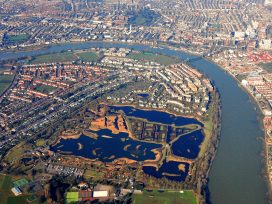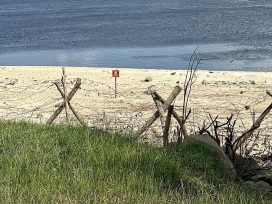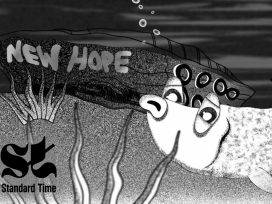The “Via Baltica” is the name commonly given to the road component of the multi-modal (road and rail) pan-European transport corridor that links Helsinki to Warsaw via Estonia, Latvia and Lithuania. The Trans-European Transport Network (TEN-T) is the EU’s Transport Infrastructure Framework. This was initially adopted in 1990 and now includes Priority Projects on 30 international axes plus wider transport projects. By 2020 it is envisaged that the TEN-T will include 89 500km of road, 94 000 km of railway, 11 250 km of inland waterway (including 210 inland ports), 294 sea ports and 366 airports. The rail component of the Helsinki-Warsaw corridor “Rail Baltica” is one of the TEN-Ts 30 Priority Projects and the Via Baltica is part of the wider TEN-T network – in other words, it is of European importance but not considered a top priority.
When Poland joined the EU in 2004, the Polish TEN-T map included a route for the Via Baltica along existing road number 8 via Bialystok – the regional capital of north eastern Poland. By this time, it was already apparent to NGOs that there were very sensitive wildlife sites in north eastern Poland that would require protection under EU nature law, but time was short during preparation and there was little, if any, official environmental analysis prior to adoption of the TEN-T maps for Poland and other accession countries. The expectation was that further analysis would be carried out to look at the most appropriate routes, including from a biodiversity perspective, before individual projects were progressed. However, the Polish authorities responsible for roads/transport are reluctant to do this and are strongly of the view that the route via Bialystok in the 2004 map is already fixed.
Nature in Podlasie
The Podlasie region of north eastern Poland has a number of key wildlife sites, including Augustow and Knyszyn Primeval Forests and the world famous Biebrza River Valley National Park, which all lie on the route of existing road number 8. All three sites are designated as Special Protection Areas for birds (SPAs) and are, or should be, proposed as Special Areas of Conservation (SACs) for protection of habitats and other species under EU nature legislation. Together, SPAs and SACs form the European ecological network known as Natura 2000.
The Augustow Primeval Forest is an extensive complex of old-growth forest (over 1000 km). The majority of the site (ca. 85%) is coniferous forest with a few open patches used for agriculture, mostly as grasslands. There are also patches of well-preserved wet and swampy coniferous forests, growing on bogs. The Augustow Primeval Forest SPA is home to at least 42 species of highly protected breeding birds. For eight of these species – Black stork, Honey buzzard, Lesser spotted eagle, Capercaillie, Grey-headed woodpecker, White-backed woodpecker, Three-toed woodpecker and Red-breasted flycatcher – the site is one of the most important breeding sites in Poland. The site also supports a large breeding population of Crane and is a breeding place for a number of rare raptor species, such as Short-toed eagle, Black kite, Red kite and White-tailed eagle. The forest is home to five protected species of mammals: wolf (26-28 individuals, 5% of the Polish population), lynx (16 individuals, 8% of the national population), otter, beaver and pond bat. The local population of elk (around 150 individuals) is also of considerable importance. Almost a fifth of the area of the forest is covered by protected habitats – 24 habitat types in all, of which 8 are EU “priority habitats” (habitats with the highest level of European protection) for example, bog woodlands.
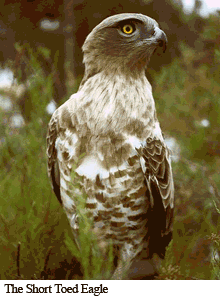
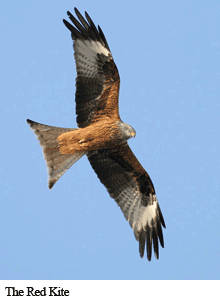
The Rospuda Valley in the north west part of the forest contains groundwater-fed (percolating) fens with hydrological conditions which are totally undisturbed, resulting in the existence of huge areas of open mires (6.3 km) covered by sedge-moss vegetation. It is the last percolating mire in the European temporal zone which is so well preserved (nearly pristine – not a single ditch and no infrastructure). The majority of the peatland area is covered by vegetation types protected by the Habitats Directive and is the most important Polish site for two plant species highly protected by the Habitats Directive: Fen Orchid (Liparis loeselii) and Kidney Saxifrage (Saxifraga hirculus). In addition there are numerous (75) plant species protected under Polish legialstion and Rospuda valley is the only site in Poland, where Musk Orchid (Herminium monorchis) occurs. Numerous rare and protected bird species breed in the Valley or the nearby forest, including Crane, Hazel Grouse, White-tailed Eagle, Marsh Harrier, Tengmalm’s Owl, Capercaillie, Spotted Crake, Honey Buzzard and Lesser Spotted Eagle.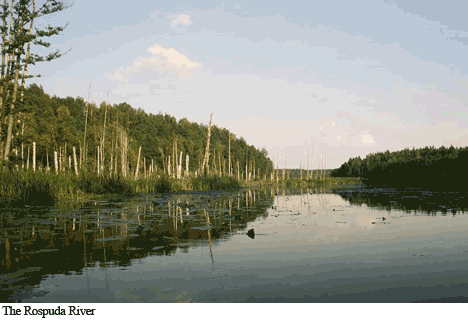
The fen complexes of the Biebrza Valley are the biggest valley bogs in central and western Europe and are almost totally unaltered by man. The Biebrza river, with numerous meanders and old riverbeds in different succession stages, still has a natural character. It regularly overflows and floodwaters persist for a long time. The process of active peat formation takes place in large areas and fen communities extend for many kilometres. Due to their strong saturation with water, they were difficult to access and only extensively managed for centuries. Forest communities such as coniferous mire woods, swamp alder woods, and mires with some sedge and reed beds are the most natural habitat types in the valley. At least 48 European protected bird species are found breeding in the Biebrza Valley. For 21 of these, the Biebrza Valley is one of the most important breeding sites in Poland and for Aquatic Warbler and Greater-spotted eagle it is the most important breeding site both in Poland and the EU as a whole. The wetlands are home to six species of mammals protected by the Habitats Directive: wolf (ca. 20 individuals), lynx (the area recently colonized by few individuals), otter, beaver, pond bat and barbastelle. They also support the biggest Polish population of elk (ca. 500 individuals) and a further 16 animal and plant species protected by the Habitats Directive. There are 15 types of European protected habitats, including four priority habitats: valuable transition mires and quaking bogs occupying over 6000 hectares, purple moorgrass meadows and coniferous mire woods. The Biebrza Valley is a Ramsar site and is legally protected as the biggest Polish national park (Biebrza National Park).
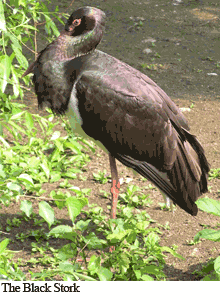

The Knyszyn Primeval Forest is a largely fragmented forest complex, many parts of which still have a natural character. The characteristic features of the site are numerous springs, clean streams and rivers. The terrain is very diverse, with differences in height of up to 80m. River valleys, largely drained, are covered by low and transitional mires. Transitional mires and, less frequently, raised peat bogs have developed on local watersheds. Coniferous and mixed tree stands with a high proportion of spruce dominate in forests. Deforested areas are covered by arable land, meadows and pastures as well as by human settlements. At least 43 European protected bird species breed in Knyszyn Forest SPA. For 10 of these – including Honey buzzard, Lesser-spotted eagle, Hazel grouse, Black grouse, Black woodpecker and Red-throated flycatcher – Knyszyn Forest SPA is one of the most important breeding sites in Poland. The forest also hosts seven species of mammals protected under the Habitats Directive: wolf (40-45 individuals), lynx (ca. 8 individuals), European bison (20-25 individuals, wild herd), otter, beaver, pond bat and barbastelle. In addition, over a quarter of the site is covered by habitat types protected under the Habitats Directive – 12 habitats in total including four priority habitats.
Knyszyn Forest, together with the Augustow and Bialowieza Forests, are the largest continuous forest tracts in north eastern Poland and are of key importance for maintaining viable populations of lynx and wolf in the lowlands of Poland and Central Europe.
Although the outstanding nature value of the above sites has been well known for decades, the Polish authorities did not propose Augustow and Knyszyn Primeval Forest as sites for protection under the Habitats Directive until autumn 2007. And it is not just these sites – there are wider concerns about the approach to European wildlife sites in Poland. In 2007, the European Commission opened an infringement procedure against Poland for its failure to designate sufficient Natura 2000 sites under the Birds and Habitats Directives. In the reference of the case to the European Court of Justice, the European Commission cited to the need for Poland to designate further sites and change the boundaries of some of the sites already designated. After the change of the Polish government in October 2007, the position of the Polish Ministry of Environment changed and it has declared its intention to complete the designation of SPAs by June 2008 and Habitats Directive sites by the end of 2008.
The Augustow Bypass
The possibility of a bypass for Augustow (a town with a population of about 30 000 people) on existing road number 8 to alleviate problems with heavy traffic through Augustow dates back to the early 1990s. At this time, the Polish Road Agency carried out an analysis of two main alternatives – one around Rospuda Valley and a second (with 4 variants) through the valley. Based on this analysis the route through the valley was chosen by regional authorities. The alternative around the valley was rejected for social and economic reasons – this route was longer and would require removal of more houses and purchase of larger number of privately owned parcels of land. The valley route was subsequently included in spatial plans adopted by the respective local authorities (Nowinka County, Augustow Town and Augustow County) in 1999-2000.
In early 2004, the Polish Road Agency started detailed planning procedures to enable construction of the road on the valley route. The project – a new 4 lane road of 17.1 km includes a 517m long bridge on concrete pillars through the mires in the Rospuda Valley. Six kilometres of the road including the bridge is within the Augustow Forest Natura 2000 site.
Under EU nature law, Natura 2000 sites must be protected and not allowed to deteriorate. In particular, when projects which may affect Natura 2000 sites are planned, a rigorous analysis of potential impacts (known as “appropriate assessment”) on the Natura 2000 site must be carried out in advance. Projects can go ahead only if they will not affect the integrity of the Natura 2000. If the assessment demonstrates that the project is likely to have an affect on Natura 2000 site integrity (for example if it effects the populations of key species for which the site has been designated) then the project can only go ahead in very limited circumstances. It must be demonstrated that there are no other less damaging alternative solutions to the project as planned (such as alternative routes), that the project is necessary for “imperative reasons of over-riding public interest” (commonly referred to as IROPI) and that compensatory measures to offset the damage to the site will be implemented. If these specific conditions are not fulfilled then any project consent granted will be in breach of EU law.
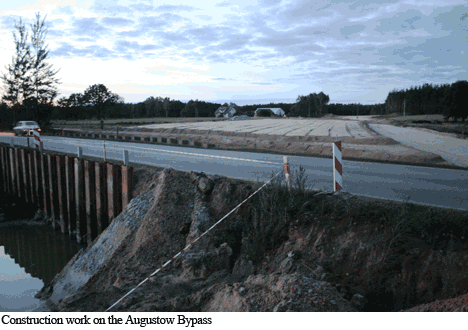
Because of very serious concerns that the planning for the project did not comply with the requirements of the EU nature laws, in early 2006 a coalition of Polish NGOs (consisting of OTOP – the Polish Society for the Protection of Birds, WWF Poland and the Polish Green Network supported by some other NGOs) submitted a complaint to the European Commission. This provided evidence of the potential negative effects on the Augustow Primeval Forest Natura 2000 site and lack of proper consideration of alternative routes. In particular, an NGO supporting public transport development has identified an alternative route which has not been properly investigated.
As well as problems with the planning for the Augustow Bypass, this complaint also raised concerns about breaches of the EU nature laws in relation to six other road projects on or related to road number 8 – the preferred route of the Polish government at the time for the Via Baltica corridor. These projects included the upgrade of three sections of existing roads and construction of the new Bypass of Wasilkow City all affecting Knyszyn Primeval Forest, one project cutting the Biebrza Valley, and a further project (in addition to Augustow Bypass) cutting Augustow Forest.
The European Commission and the European Court of Justice
The European Commission (EC) investigated the case and, when it was unable to resolve the situation through informal contact with Poland, in December 2006 opened legal proceedings. It sent Poland a “first written warning” about 8 road projects in north eastern Poland – new roads, bypasses or upgrades all linked to the Via Baltica Helsinki-Warsaw road corridor, on the basis that in authorising these projects, Poland breaches several provisions which aim to mitigate deterioration of nature sites of European importance.
Poland failed to provide a satisfactory response to the EC and in February 2007 gave contractors the green light for clearing work for the Augustow and Wasilkow Bypasses. This prompted the EC to send Poland a “final written warning” concerning the damage that will be done to primeval woodland and other natural habitats of European importance if construction of the two bypasses goes ahead. The EC stressed that it supports the upgrading of road infrastructure in Poland – including along the Helsinki-Warsaw road corridor – but it does not accept that the irreversible damage that will be caused by the bypasses is either necessary or justified. As clearing work was imminent, the Commission asked Poland to respond within one week. This was an unusual step reflecting how urgently the Commission was treating the matter – normally Member States are given two months to respond.
Unfortunately, despite this second warning Poland remained unmoved and construction work on the two projects started. Hence, in March 2007 the EC referred the case to the European Court of Justice (ECJ). The EC were so worried that Poland would damage Natura 2000 sites with the Augustow Bypass works, and about the proposed compensation measures linked to this project to be implemented in another Natura 2000 site, they took the unusual step of applying to the ECJ for an order requiring Poland to stop the imminent implementation of the compensation measures programme until the ECJ has had chance to consider the full case. In April 2007, such a temporary order (effectively an injunction) was granted. This was the first time such an order has been made to protect a Natura 2000 site from imminent damage by a development – a new precedent.
Despite the strong actions of the EC and ECJ, in July 2007 it became clear that Poland still intended to start construction in Rospuda Valley in August – immediately after the end of the birds breeding season. Hence, on 30 July 2007 the Commission made an urgent application to the ECJ to order Poland not to start road construction in Rospuda Valley. The situation was only resolved when Poland provided the ECJ with official confirmation that they would not undertake works inside the Augustow and Knyszyn Forest Natura 2000 sites until the ECJ has considered the case in full.
The case is now at the written procedure stage – which involves the EC and Poland, and also Latvia, Lithuania and Slovakia, who have got involved in the case to support Poland, are exchanging written documents. This stage is not public, the next public stage will be a hearing on the case at the ECJ – which could be some time in 2008
The European Parliament
The case has also gained a high profile at the European level due to the interest of Members of the European Parliament (MEPs). The first visit of MEPs to north eastern Poland to investigate the Via Baltica case was by members of the European Parliament’s (EP) Committee on Environment and took place in 2005 – a year after Poland joined the EU. After Polish NGOs submitted a petition to the EP’s Petitions Committee in 2006, the committee agreed that the case is of European concern and decided to examine it in detail. A fact-finding mission to Poland took place in the summer of 2007 and resulted in September 2007 in a report strongly critical of the Polish government. This MEP report recommended Poland to consider the alternative route for the Via Baltica express road, urged the Polish authorities not to proceed with any construction or destruction in the Rospuda Valley or other protected areas, considered that EU funding should only be allocated to Via Baltica if the route is selected on the basis of Strategic Environmental Assessment and is in strict conformity with European Directives, and recommended that EU support should be made available for rail freight and passenger transport between Finland and the Baltic States and Warsaw.
The new Polish government and the “Rospuda round table”
Following the change of Polish government in autumn 2007 and cancellation by a Polish court of one of the key planning consents (the environmental consent) for Augustow Bypass through Rospuda Valley, the new Environment Minister convened a round table stakeholder process to discuss the possibilities for solving the problems with Augustow Bypass/Rospuda Valley. In January/February 2008 three meetings were held bringing representatives of the Polish Road Agency, local and regional authorities, NGOs, local politicians, experts and the Ministers of Environment and Infrastructure together to discuss the Augustow Bypass issue.
The round table agreed that the next step should be Environmental Impact Assessment (EIA) with “appropriate assessment” (as required under the Habitats Directive for projects that might affect a Natura 2000 site) for Augustow Bypass considering three possible routes. One of these routes would bypass the Natura 2000 site completely, a second would cut only a small part of the Natura 2000 site and the third route is the Road Agency’s preferred route right through the mires in the Rospuda Valley section of the Natura 2000 site. The Polish authorities have just issued a tender for assessment work, which is expected to be finished by the end of October 2008. Then the new environmental consent will be granted for the most appropriate route.
Very worryingly, although it has been decided that the new assessments are required to decide the legal route of Augustow Bypass and the environmental consent for the current route through the mires in Rospuda Valley has been cancelled, construction works are still continuing on the sections of the Road Agency’s preferred route outside the Natura 2000 site. Therefore, the road could end up being completed right up to the boundaries on both sides of the Natura 2000, before a new decision is taken.
Related road projects
Although the Augustow Bypass situation is relatively promising, the NGOs remain worried that the Polish authorities are still progressing other Via Baltica road projects related to road number 8 – the Polish authorities preferred route for the international Via Baltica corridor. For example, in early 2008 ground clearance works were carried out inside Knyszyn Forest Natura 2000 site for the planned Bialystok-Katrynka road upgrade project. Other road projects, while still currently at the planning stage, are being continuously developed towards implementation.
In total there are 11 Via Baltica road projects of concern at different stages of planning, including a proposed Bypass of Sztabin likely to affect Biebrza Marshes Natura 2000 site. What is urgently needed is for the Polish authorities to take a strategic decision on the best route for the entire Polish part of the Via Baltica.
The SEA: opportunity for a strategic solution
In 2003, the Bern Convention (Convention on the Conservation of European Wildlife and Natural Habitats, part of the Council of Europe), following an on-the-spot appraisal by an expert, recommended that Poland complete a full Strategic Environmental Assessment (SEA) in conformity with EU procedures in order to minimise as far as possible any deterioration of important areas and take the results of the SEA as a basis for a decision on the routing of the “Via Baltica”.
An SEA examining the most appropriate route has been underway under the order of the Polish Roads Agency since 2005. The SEA experts’ (international consultants Scott Wilson) finalized a “Strategy for Via Baltica expressway development” and accompanying SEA report in November 2007 and this was accepted by the SEA Steering Committee (which includes NGO representatives) on 12 December 2007. This SEA report, which analysed four possible routes in detail, recommends a route for the Via Baltica corridor through Lomza rather than the Polish authorities” preferred route on road 8 – the route that will affect at least 3 Natura 2000 sites (Augustow and Knyszyn Primeval Forests and the famous Biebrza Marshes).
However, the SEA process has slowed down over the last few months and it has only recently been announced by the Road Agency that the next step will be taken soon. The strategy and SEA will be subject to public consultation before a final decision is taken on the route. The NGOs are worried about the real will of the Polish authorities to finish the SEA process. Also that in advance of completion of the SEA process, decisions continue to be taken on a number of road projects on road 8/S-8 and connected road 19/S-19, which is likely to foreclose the proper consideration of alternative routes and frustrate the SEA process. In fact, Poland is even seeking EU funding for some of these projects – according to the Polish Operational Programme “Infrastructure and Environment” (2007-13).
In relation to this, the September 2007 report of the Petition’s Committee stated “that EU funding should only be allocated to Via Baltica in North-East Poland if the route is selected on the basis of a properly conducted SEA and is in strict conformity the spirit and the letter with European Directives, bearing in mind the precautionary principle”.
Conclusions
NGOs strongly hope that the Polish authorities select an alternative route for Augustow Bypass as a result of the Round Table process and also take a strategic decision on the route for the entire Via Baltica route corridor based on the SEA as soon as possible, in order to protect nature of European importance and alleviate the problems for local residents caused by heavy traffic. We do not believe that these gaols are mutually exclusive – as discussed above – there are alternative, more sustainable, solutions. We also hope that the European Commission adheres to the Parliament’s suggestion and does not fund any projects in the Polish Operational Programme “Infrastructure and Environment” (2007-2013) related to road 8 until the strategic decision on the entire Via Baltica corridor has been taken.
The Via Baltica case also raises a number of wider issues. They include how tough the European Commission and ECJ are prepared to be where Member States do not comply with EU nature laws; the complications that can arise when planning of projects (infrastructure and other types of project) begins prior to a country joining the EU; and the need for the development of sustainable transport projects. The EU nature directives can support the development of such projects, help identify alternative solutions and providing planning security. There are positive examples, including in Poland, where the feasibility study for the selection the most appropriate route for the Rail Baltica railway demonstrates how biodiversity and other environmental considerations can be integrated into transport planning. However there are also many negative examples and scope for many more “Via Baltica” conflicts across Europe. If this approach to project planning prevails, for example through implementation of the EU TEN-T network, then the Natura 2000 ecological network will be under serious threat and the achievement of the EU’s commitment to halt biodiversity loss within the EU by 2010 in real jeopardy. There is an urgent need to look for more sustainable solutions.
